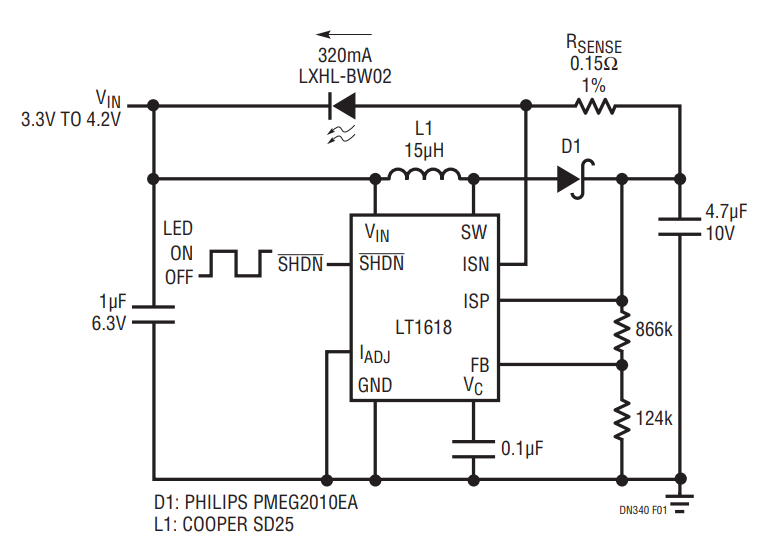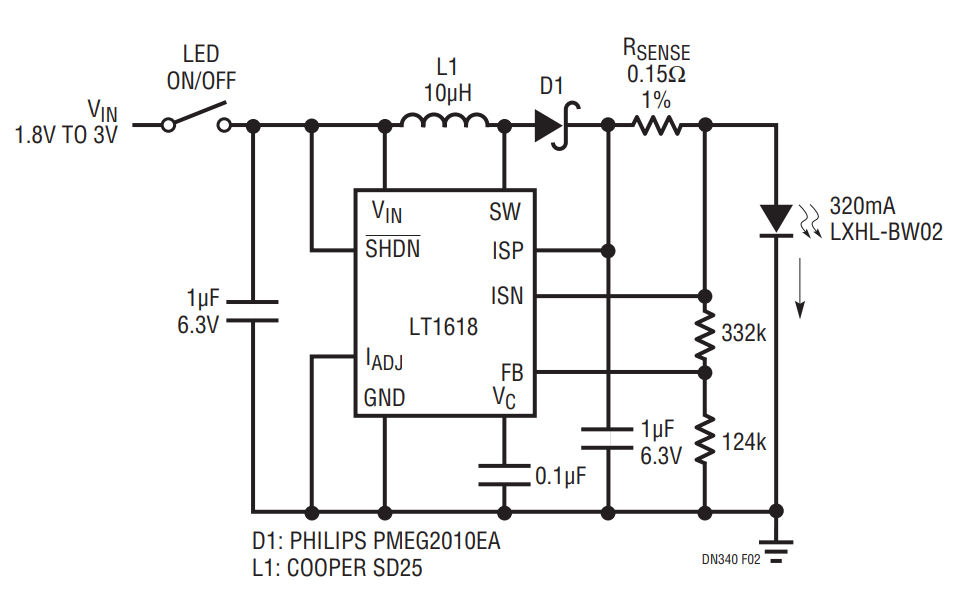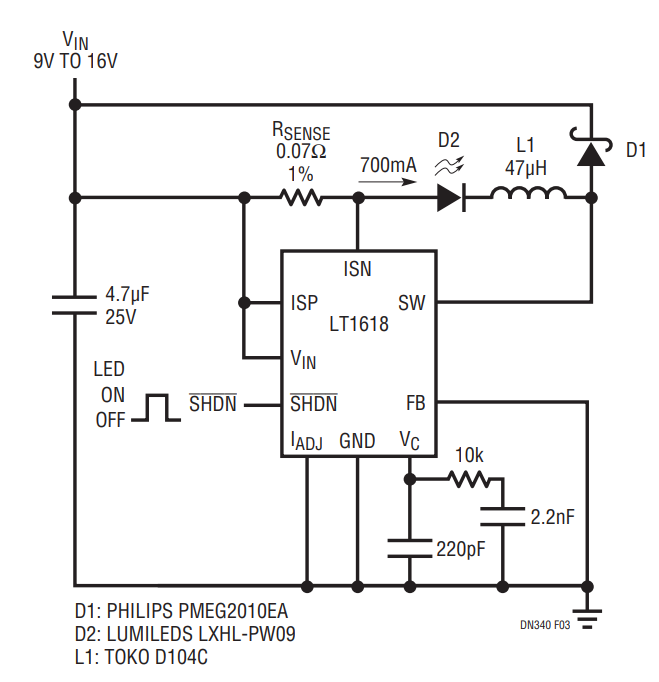Design Note 340: DC/DC Converter Drives Lumileds White LEDs from a Variety of Power Sources
Introduction
LEDs are usually driven with a constant DC current source in order to maintain constant luminosity. However, most DC/DC converters are designed to deliver a constant voltage by comparing a feedback voltage to an internal reference via an internal error amplifier. The easiest way to turn a simple DC/DC converter into a constant current source is to use a sense resistor to turn the output current into a voltage and use it as the feedback. The problem with this method is its reduced efficiency—700mA across a 1.2V (typical reference voltage) drop produces an 840mW power loss. One solution is to use an external op amp to amplify the voltage of a low value resistor to the given reference voltage. This saves converter efficiency, but significantly increases the cost and complexity of a simple converter with the additional components and board space.
A superior solution is to use the LT1618 constant current, constant voltage converter, which combines a traditional voltage feedback loop and a unique current feedback loop to operate as a constant-voltage, constant-current DC/DC converter. No external op amps are required for this extremely compact solution. The IADJ (current adjustment) pin provides the capability to dim the LED during normal operation by varying the resistor setting or injecting a PWM signal. Access to both the positive and negative inputs of the internal constant-current amplifier allows the sense resistor to be placed anywhere in the converter’s output or input path and provides constant output or input current. Without access to both inputs, either a ground referenced sense resistor or some additional level-shifting transistors or operational amplifier would be required.
Lithium-Ion Source (3.3V to 4.2V)
The LT1618EDD is a 1.4MHz constant-current, constant voltage boost converter in a tiny 10-pin thermally enhanced DFN package. The monolithic (onboard) low side switch has a maximum peak current limit of 1.5A. This enables extremely compact high-current solutions for portable and battery-powered applications. The high switching frequency allows the input and output capacitors and the inductor to be extremely small.
Although the LT1618 is conventionally used as a high frequency boost converter with the load being driven between VOUT and ground, the unique method, shown in Figure 1, of tying the load from VOUT back to VIN allows it to be used to drive the LXHL-BW02 1W white LED from a lithium-ion battery input. Tying the load back to VIN allows the forward voltage of the LED (the load voltage) to be either above or below the input voltage as the battery voltage changes. This topology avoids the need for an additional inductor as would be required in other buck-and-boost topologies such as SEPIC or flyback.

Figure 1. The LT1618 Powers the LXHL-BW02 White LED from a Single Lithium-Ion Battery with 70% Efficiency.
The single inductor used here is extremely small and low cost, matching the tiny all-ceramic capacitors and low-profile IC. Tying the load back to VIN increases the inductor current by summing both the input and output currents. Due to increased switch losses, the overall efficiency of the solution is approximately 70% over the input voltage range. Nevertheless, at this efficiency, it is difficult to match the compactness and low cost of this solution. The LED is turned off by grounding the SHDN pin and input or output disconnect is not required.
The constant-current sensing resistor, RSENSE, is only 150mΩ. At 320mA, it dissipates about 15mW. RSENSE is tied directly to the positive and negative input pins of the LT1618 and is placed in the path of the LED, returning to VIN. The LT1618’s access to both the positive and negative pins keeps this circuit simple and compact.
2-Alkaline Cell Source (1.8V to 3.0V)
Powered from two alkaline cells, the circuit in Figure 2 can illuminate a 1W LXHL-BW02 Lumileds white LED with a constant 320mA current at 85% efficiency. The forward voltage of the 1W LED, 3.6V typical, requires a boosted voltage from the 2-cell input. In order to turn off the LED, an input disconnect switch is required. Typically in handheld lighting applications, this is a simple pushbutton or switch. Without input disconnect, the shutdown pin would only prevent the IC from switching, still providing a direct path of current from the input to the output through the inductor and catch diode.

Figure 2. The LT1618 Powers the LXHL-BWO2 White LED from Two Alkaline Cells with 85% Efficiency.
Automotive Power Source (9V to 16V)
With floating sense resistor inputs, the constant-current LED can be placed in DC/DC converter circuits where one would not normally think to place a load. For example, Figure 3 shows the LXHL-PW09 white LED placed in the input path of what appears to be a boost converter with VOUT connected to VIN. In fact, the forward voltage drop across the LED allows the boost topology to provide what would be an output of VIN while it appears to see an input of VIN – VF (3.6V typical forward voltage). However, the load that is driven is the white LED with a constant 700mA current at approximately 70% efficiency. This circuit is therefore a buck that uses a boost converter. One advantage of this topology is that only a single input/output capacitor is required, but an increased inductor size is needed to limit the ripple seen by both the LED and the input/output capacitor. Once again, the SHDN pin can be used to turn the LED on and off without the need for an input or output disconnect switch.

Figure 3. The LT1618 Powers the LXHL-PW09 White LED from an Automotive Battery with 70% Efficiency.
Conclusion
The LT1618 has many features that make it an ideal IC for providing constant current to Lumileds white LEDs from a variety of power sources.
